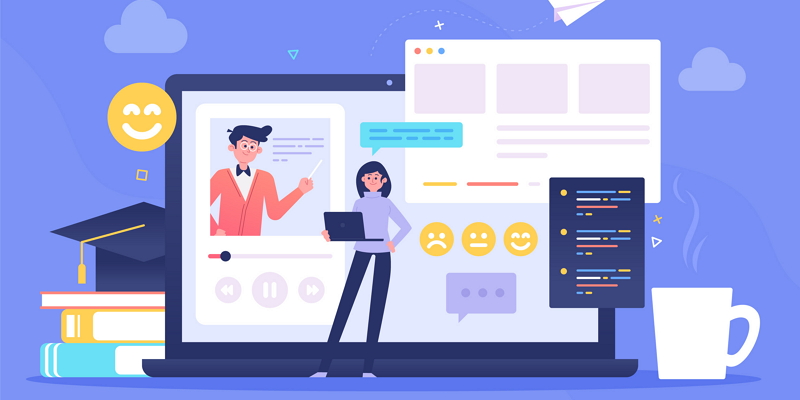
Guest Author: Aleksandra
In this article, I will write about the basic conditions that every online course should meet.
Although there are various forms of knowledge transfer via the Internet, online courses are only one type of online learning.
When creating them, every instructional designer should keep in mind the following items, which will be described below. Of course, these are just the key points. Perhaps with the development of technology and new learning theories, these key points will go down in history or will be contextually expanded.
1. Simple work environment
For a participant to feel safe in a work environment on the Internet, that work environment must have a good user interface. What does it mean? In short, you need to make sure that the participant learns what is intended, without having to study the platform on which he is learning for too long. If the participant first has to master the platform on which he is learning, and only then move on to specific content, his motivation to learn will greatly decrease. The worst scenario is that the participant spends more time navigating the platform than on the content of the course itself.
Most educators first need to decide which learning platform to use. The technical solution means the choice of the platform, ie LMS (Learning Management System) software that will be used for the distribution of courses. There are many of them on the market, and before you make a decision on which one to use, you must research them well, that is, test the trial versions.
The most important thing for the participant is that the work environment is not too complicated. This means:
* Easy registration for the participant,
* There should be simple instruction for participants on how the platform works.
2. Quality and clear course content
We can say that a course has excellent quality if the content of the course can improve and expand knowledge, and then apply it in practice. A good online course always offers specific knowledge that you can use in daily life.
For a course to be considered quality, it must meet the following conditions:
* It should be written in clear language;
* It is well structured didactically;
* Has elements of narration (or “tells a story”);
* Content goes from easy to hard;
* Is written in an easy-to-understand way, but it also has an expert review of the content.

For the content to be well created, it is a prerequisite that the goals and outcomes of the online course are well defined in advance.
The length of the content must be in line with the topic covered in the online course. It should not be too short and superficially processed, because in that case, the participants will not have the acquired knowledge after completing the course. Also, one should not exaggerate and be too extensive. ?
Goals and outcomes
Watch a short video below about creating goals and outcomes for an online course.
3. Interactive content
The content of the course must not be boring for the participants.
If you only see lines and lines of text in the course, without any multimedia content to enrich it, you are actually reading a PDF document. For some content not to be boring for the participants, it is better to enrich it with exercises, examples, scenarios, tests, tasks, simulations, dialogues, case studies, links, manuals, presentations and more.
The quality of the online course will increase significantly if you make it interactive and allow participants to be active in the learning process.
Depending on what you want to achieve, you will use a program or web tool to create exercises for participants.
Check out the tools I recommend and use below.
The list of programs and web tools used by the experts are numerous, and I will deal with this topic in more detail in one of the following articles. These are just some of the most popular ones at the moment.
Pay attention!
When using interactivity in an online course, be careful that the interactivity elements are justifiably embedded in the content.
The following should be taken into account:
* Not to add animations, sound, or colorfulness if it is not necessary, i.e., didactically justified;
* Not to overdo the number of interactive exercises.
Interactive content does not serve to visually enhance the course, but to encourage participants to take action.
4. Communication on the online course
Many creators of online courses neglect this important segment, and many of them consider it completely unnecessary.
However, when a participant learns something, he should get some feedback about his work and progress, but also needs someone he can ask for an opinion or suggestion if there are any misunderstanding. Exchanging opinions and ideas with other learners and working as a group also encourage the provision of knowledge to the participants.
A characteristic of online courses is the lack of personal contact between the lecturer and the participant. However, this challenge can be overcome in two ways:
- Forums for discussion within the learning platform;
- Direct communication with the author/lecturer of the course.

As in live communication, similar rules apply to online communication. If you are a course instructor/moderator, try to:
* Respond regularly to incoming messages from participants;
* Admit if you overlooked or made a mistake;
* Be kind and friendly when replying to messages;
* Use your knowledge to help participants master the content of the course.
In this way, you will provide your students with good and quality feedback and you will be able to overcome the lack of personal contact.
5. And what happens after the course?
Many courses do not have a clear outcome for participants after completing the course. Therefore, from the beginning, it is very important to define the goals and outcomes of the course, as well as the competencies that the participant will acquire at the end of the course. To be able to say that an online course has good quality, it must ultimately have a final product. The final product is what the participant created independently, but with the help of the knowledge acquired in his course.
You wouldn’t want to go back to the course after which you have the feeling that you have learned something new, but you might have no idea how to implement it in practice. This brings us back to the story of well-edited content, which is important to enrich with real-life or business examples.
Suggestions for ensuring the knowledge of participants after the course are:
Post-course activities – make sure your participants try out the knowledge they have acquired in the course in real life. Give them real-life opportunities and advise them on how they can use their knowledge.
Social networking – allow participants to connect with each other. Refer them to groups, forums, a community where they can find similar people with whom they will be able to share knowledge and experience and thus expand existing knowledge.

These are just some of the elements that are important for the development and creation of online courses but by no means the only ones. Anyone who embarks on the adventure of creating and distributing online courses should keep in mind that this area is very wide and that it is impossible to learn it from just one blog post.


